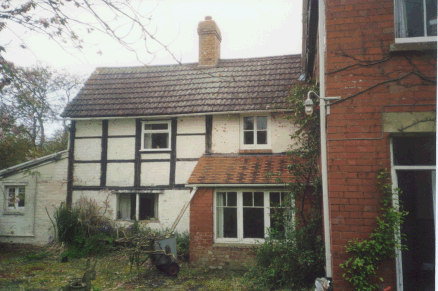
Visiting the roots of our family tree
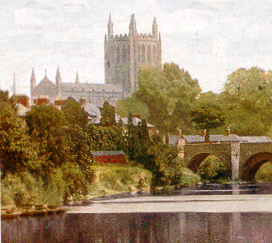
A
fter the Family Gathering in April 2002 my cousin Sheila Rubery (who now lives in Canada) came to stay with me for a few days. Naturally I was keen to show her some of the places in Herefordshire which were associated with our family in the past. We started out in Hereford city itself where our great-great-great-great-grandparents, Thomas and Ann ROBERY had come to live in the mid-1760s. The baptisms of their last four children are recorded in the parish registers of Hereford All Saints and Hereford St Martin. But as the latter church was destroyed in the Civil War (having stood without the City Walls), and not rebuilt until 1850 all of these baptisms would actually have taken place in the church of All Saints.
Ann and Margaret then surrendered the Tenement and premises back into the hands of the Court and it was regranted to Thomas and Ann ROWBURY by the rent of ten pence by the year and all other Services therefore before due and of right accustomed and they give the Lord for a fee for the Grants aforesaid three Pounds three Shillings and are admitted Tenants thereof...
Also there was a further tenancy of One acre of arable Land Situate in a Common Field called Brookway which was left by Edward BAGLEY to his brother, Thomas BAGLEY, who also surrendered it to the use of Thomas ROWBURY and Ann his wife.
On the 10th April 1761 it is recorded that on the 11th June 1760 this property was surrendered by Thomas and Ann ROBREY the said Ann being first examined privately and Apart from her Husband to the use of John PARRY Clerk, Thomas PHILLIPPS Esquire and John MORGAN Gentleman, on Mortgage for Securing the repayment of Forty Pounds and Interest after the rate of four pounds for one hundred pounds by the year. A note in the margin says that the property was Surrendered to Thomas Tristam 8th May 1767 and Thomas and Ann must have left the property about then as the first baptism in Hereford All Saints took place on 14th August of that same year.
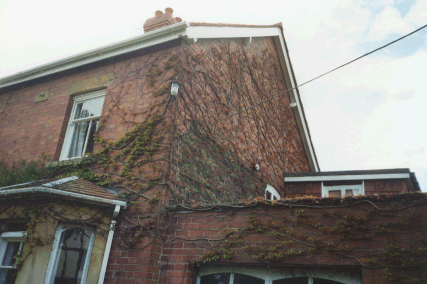
A private deposit of documents relating to the sale of St Donats in Eaton Bishop in 1973 and of deeds relating to its ownership contains a copy of the surrender mentioned above, dated 10th April 1761. This suggested that St Donats was the tenement which had been occupied by Edward BAGLEY and then the ROBERYs. The sale documents included a map showing exactly where the property was. We went there, and I got out of my car to try and take a photograph. Finding that it was almost impossible from the road I knocked on the door to ask permission. Well I was glad that I did that - the owners were very kind and not only granted me permission to take pictures but also invited us in. They then shared with us the many old pictures, maps and tales of the house that they had acquired, being interested in its history themselves.
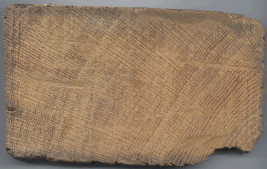
Whilst a lot of work had been done to the house in the late 19th or early 20th centuries to turn it into a brick clad "gentleman's residence" there were many places where older fabric could be seen. This included a timber-framed outhouse and dairy and a portion of original stone wall (see photographs).
The then owners had lived there for 30 years and had done a lot of work on the house, and outbuildings, and during the course of some of the renovations they had had some of the beam wood examined to find out when it was cut. It was dated to 1511. I came away with one of the slices that had been used for the ring count!
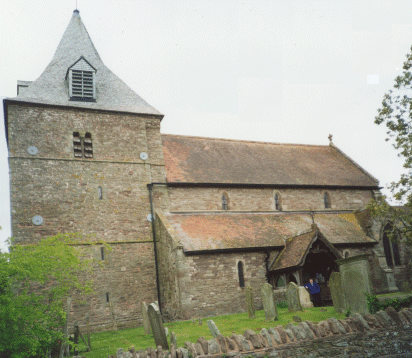
After leaving there we paid a visit to the church at Eaton Bishop. This still consists of much of its original building, and the tower which dates from the 12th century was probably built (like many in the Welsh marches) as a stronghold against Welsh raiders. But the glory of the church is its 14th century East Window complete with beautiful stained glass of the same period, in colours of brown, green and yellow with little red and less blue and draftmanship similar to illuminated manuscripts.
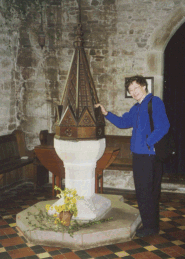
From here we went to Thruxton, where Thomas had been baptised in 1731. The photograph shows Sheila standing by the font. After this we went to neighbouring Kingstone church, where the eldest of his four siblings had been baptised. It is the records of this church which gave the proof of the GOMERY link. The first child John is recorded as ROBERY in the parish registers, but the entry has clearly been altered, although from what is not apparent. Checking the Bishop's Transcript for that year show that the entry originally read GOMERY
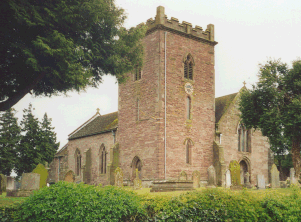
All these parishes are fairly close together, and it is easy to see how people would move from one to the other as better prospects of work etc opened up to them. However Thomas's father had been baptised at Woolhope, some distance away to the south-east of Hereford. But he married at Holmer, a parish to the north of Hereford in 1720. It is not clear why the marriage should have taken place there as both bride and groom are said to be of different parishes. These are not far from Kingstone and although we did not stop to visit the churches themselves we did stop long enough to take photographs of them from the road.
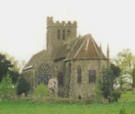
The bride, Elizabeth JONES, was said to be of Madley. We travelled west from Kingstone and to our right were treated to a marvellous, low rainbow lying over the dishes of the Satellite Earth Station, and then along the Roman Road which led to the Roman town of Magnis, nowadays Kenchester. This persumably crossed the River Wye by a ford, such as the one which gave Hereford its name. The church at Madley lies off the road that we were passing along (the B4352) and the photograph shows it as it appears to travellers such as ourselves on that road.
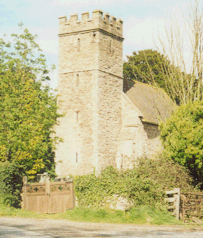
The bridegroom, John GUMRY, came from Bridge Sollers, the site of the first bridge for several miles upstream of Hereford. (This bridge has been rebuilt since our visit.) The small church is perched at the top of the hill as one comes up from the river crossing. From here we sped along the main road turning through Stretton Sugwas (the name indicating it lay on a Roman road) to drive along the road which travels from Magnis to the north of Hereford. This brought us to Holmer church. Sadly the church was locked and so we could only admire it from the outside. The church has a detached bell tower. There are quite a few of these in Herefordshire.
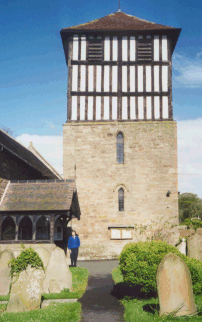
Finally from here we travelled to Woolhope to the church where John GOMBERRY alias ROWBERRY had been baptised in 1692. We were lucky in that the churchwarden came to lock the church whilst we were in it, and so we had a pleasant chat with him before leaving. Woolhope is situated on a unique limestone dome which is famous for its geology, fossils and natural history. The church still has much of its medieval stonework, although it was extensively repaired and modernised in 1882. The ROWBERRY alias GOMERY family, apart from our John, remained here for several more generations eventually taking the GOMERY or GUMMERY name. Today many still live in the neighbourhood.
Why did John leave and travel away? Of course all of these parishes would have attended markets and fairs in Hereford, maybe he just went to a Hiring Fair there and had to travel to where work was offered to him. And where did the family come from before they first appear in the parish registers of Woolhope in 1691/2? If they did come from the Tenbury area what brought them here? Hopefully one day further research and discoveries may shed some light on these questions but for this day we had reached the original "roots" of our known family tree.
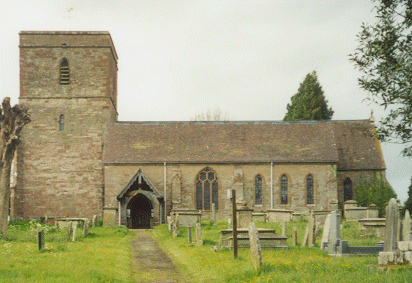
After running out of tree at Woolhope we drove on through Ashperton and Ledbury and then around Malvern to enjoy the view. The cider orchards were in blossom and the sun had come out, after what had been a somewhat drizzly day and we found an added bonus of the all the Malvern wells having been dressed. We finished the day off with a pub meal having missed our Sunday lunch.
Well I hope that you have enjoyed this account as much as we enjoyed our day!
URL= http://www.rowberry.org/roots.html
Last revised: 9th January 2010
© Polly Rubery 2002-2010